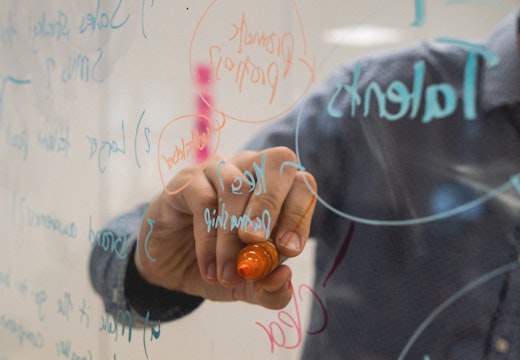Seven design thinking principles that will help hybrid work succeed
Too much technology integration for the hybrid workplace is currently missing the mark. A novel approach by Canada’s ET Group uses design thinking to develop more human-centred solutions
As the adoption of hybrid working grows globally, one of the toughest challenges facing organisations is how to integrate technology into their strategies, spaces and systems. Everyone agrees that the effective tech integration can unlock new ways of working, but there is far less consensus on the best way to go about the process.
In particular, there is concern that a standard approach to integrating technology for hybrid work will lack a human-centred perspective, making innovation in this area less effective than it should be and failing to meet the needs of the people who will drive the organisation forward.
In this editorial series, we’ve been partnering with Canada’s ET Group, a leading collaboration technology integrator, to look a different approach based on bringing design thinking (DT) principles into hybrid work projects. This final article in the series summarises what we’ve learnt.
An alternative angle
Design thinking first emerged in the immediate aftermath of the global financial crash of 2008 as companies sought new paths to innovation and an alternative angle to address business problems. Corporate adoption was rapid in a range of fields from consumer goods to financial services.
The workplace was generally slower to take DT methods on board, but that could be set to change as organisations seek to build more inclusive work environments in the aftermath of the pandemic and use technology to unite a flexible workforce.
‘Design thinking allows us to understand the different views of different users’ – Dirk Propf, ET Group
ET Group has pioneered the use of DT with a range of international clients over the past five years, refining its techniques along the way. ‘Design thinking allows us to understand the different views of different users, so we are not just designing technology for the sake of technology,’ says ET Group CEO Dirk Propfe. ‘That’s why we’re taking this approach.’
In the first article in this series, we studied the contours of ET Group’s approach and, in the second, we explored how its application of design thinking has enabled it to work more effectively with workspace designers. Our third article focused on the role of empathy within the DT process, and our fourth piece examined the dimension of human experience.
Here are seven key principles of design thinking that underpin integration of technology for hybrid work:
1 Adopt a participatory mindset
Too many technology solutions are based on an expert mindset that dismisses or downgrades the perspective of the end user. Design thinking brings a different mindset to technology integration – one that is participatory rather than expert. ET uses a range of methods to look at things through the lens of the user – from one-to-one confidential conversations and immersive role-playing to asking people to tell stories about their experiences. Lisa Perrine, a strategic partner and advisor to ET Group in this field, describes DT as a collection of methodologies ‘that allow a group of diverse people to work together and use their own experience to solve a problem – the clients are co-creators.’
2 Show empathy
Engineers are trained to focus on scientific objectivity and technical factors rather than on human behaviour. So, empathy and technology are two words rarely used together in the same sentence when talking about the workplace. But showing empathy with end users – a central idea in design thinking – is a smarter tool for project engagement than scientific neutrality. ET Group CEO Dirk Propfe describes empathy has ‘walking a mile in the user’s shoes’ and ‘understanding needs from different perspectives’. According to Lisa Perrine, ‘Empathy is woven through the entire process. It is at the root of everything we do when we co-create with users, test ideas and pilot designs.’
‘Empathy is woven through the entire process’ – Lisa Perrine, ET Group
3 Focus on human experience
People find it easier to describe their day-to-day experiences with technology than they can the technology itself. This makes the experiential aspect of projects increasingly important. Technology is both an enabler of hybrid working and a significant factor in creating positive or negative experiences for employees. Design thinking brings experiences to the fore via the ‘double diamond’ model at the heart of the process, which plots innovation across four stages (discover-define-develop-deliver). The ‘problem diamond’ (discover-define) is where existing experiences are observed and analysed. The ‘solution diamond’ (develop-deliver) is where new and more ideal experiences are prototyped and tested.
4 Prototype early and often
Prototyping of potential solutions to test with users is a key part of ET’s approach – and one of the core values of design thinking. 2D, 3D and 4D full-sized mock-ups are built to explore and get feedback on new experiences, using the digital fly-through to show the possibilities. The process can be iterative and messy, but the project team learns a great deal from these experiments. ‘If it’s a prototype, don’t expect to get it 100 per cent right first time,’ says Lisa Perrine. ‘Try one thing and see how people respond and go from there. Don’t fast-track entire solutions before we know it’s the right solution.’
5 Fail fast
The use of rapid prototypes and mock-ups is linked to the idea of failing fast to succeed sooner. Too much tech innovation plays safe and makes only incremental improvements. Making it safe to fail is among the central tenets of design thinking. Michael Oppedisano, Project Lead at ET Group, explains: ‘Our approach is to brainstorm, prototype and deploy. There may be a scenario that no-one thought about. We then learn from our failures, improve on them, and deploy more widely.’
6 Don’t jump to solutions
Many technology integration projects rush down a linear path to an end point, whether or not it has been proven to work for employees or is even solving the right problem. Design thinking has a deliberate focus on the front-end of the innovation process – those discover-and-define phases that wrestle iteratively with the problem from every angle – rather than a reflex rush to delivering solutions. ET Group uses graphic artists to record the co-creation activities on each project so that clients have a visual record of those key discussions and decisions that address the problem.
7 Create a shared platform
Finally, there needs to be a shared vision of the key success factors on any hybrid working project at the outset – and a shared methodology too. Wires can get crossed between design professionals and technology integrators; objectives can become obscured and parallel programmes can get out of alignment. Joint use of design thinking principles enables both camps to march to a single drum so that space and technology can be combined to optimum effect to enhance the employee experience.








